3.12 Pediculosis (Louse infestation) – Large Animals
Learning Objectives
- Know if lice can be easily transmitted between species.
- Learn when louse infestation is harmful to an animal.
- Know the economic importance of louse infestation.
- Learn how long lice can live off the host.
- Learn the favorite body sites for sucking and biting lice.
- Learn how to manage louse infestation.
-
General Considerations
- Louse infestation is common and it is called pediculosis.
- Lice are highly host-specific, obligate parasites that spend their complete life cycle (20 to 40 days) on the host.
- Infestations are only harmful to the animal when remarkably heavy.
- Young animals in poor condition and on a low level of nutrition are most likely to have heavy infestations.
- Even a moderate degree of louse infestation is of economic importance because of the resulting hide damage and decrease growth.
- Transmission occurs by direct contact or indirect contact with contaminated bedding or other inanimate objects.
- Louse infestation is a greater problem during the winter when crowding is a problem, nutrition may be poor, and animals have a long coat. All these factors provide a good environment for louse to thrive.
- Under favorable environmental conditions, lice can live 2 to 3 weeks off the host but less than 7 days is typical.
- Biting lice feed on exfoliated epithelium and cutaneous debris. Sucking lice feed on blood and tissue fluid.
- Nits 1 to 2 mm long are attached to hairs by a clear adhesive secretion secreted by the female lice.
-
Cause
- Equine:
- Damalinia (Werneckiella, Bovicula) equi: biting lice.
- Hematopinus asini: sucking lice.
- Bovine:
- Damalinia bovis: biting lice.
- Haematopinus eurysternus (the short-nosed louse); Linognathus vituli (the long-nosed or blue cattle louse); and Solenopotes capillatus (the little blue cattle louse). All these are sucking lice.
- Ovine:
- Damalinia ovis (body louse): biting lice.
- Equine:
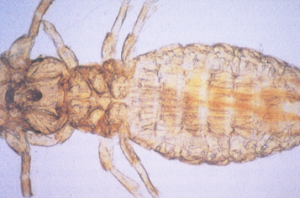
-
-
- Linognathus ovillus (face louse); Linognathus pedalis (foot louse). Both are sucking lice (the head is narrow and pointed).
-
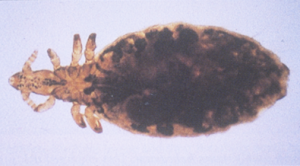
-
- Caprine:
- Damalinia caprae: biting lice.
- Linognathus stenopsis: sucking lice.
- Caprine:
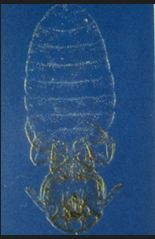
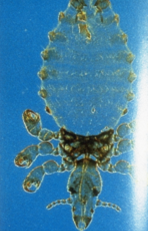
-
- Swine:
- Haematopinus suis: sucking lice.
- Swine:
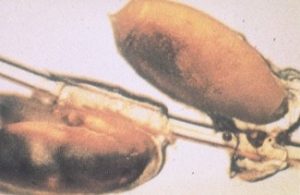
-
Clinical Signs
- Equine:
- Lice often cause intense pruritus and the self-trauma results in excoriations and alopecia.
- The skin becomes scaly and the coat acquires a dull appearance.
- Biting lice (Damalinia equi) prefer the dorsolateral trunk.
- Sucking lice (Haematopinus asini) prefer the mane, tail, and fetlocks.
- The animals can become debilitated if heavily infested.
- Sucking lice can cause anemia if the infestation is heavy and chronic.
- Equine:
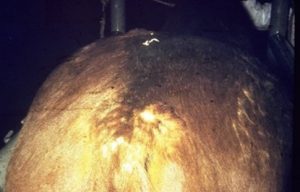
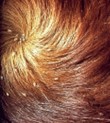
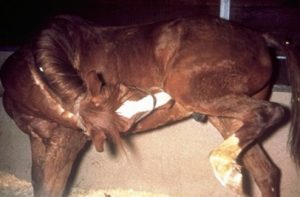
-
- Bovine:
- Sucking lice are found around the poll, nose, eyes, neck, brisket, withers, tail and axillary and inguinal areas.
- Biting lice are more common in areas of the neck, withers, and tail head.
- No clinical signs are present with light louse infestation.
- Heavy louse infestation causes skin irritation and scratching, which leads to restlessness, damage of hides, and loss of weight gain or milk production.
- Pruritus leads to a rough and disheveled coat, patchy alopecia and excoriations.
- Hairballs may be common in calves due to licking.
- Severe louse infestation with sucking lice may result in fatal anemia with packed cell volumes as low as 10%.
- Bovine:

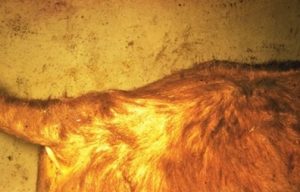
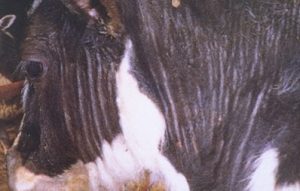
-
- Ovine:
- Clinical signs are as described for cattle.
- Damalinia ovis louse is commonly found on the neck and back.
- Linognathus pedalis louse prefers the lower leg and has also been known to cause lameness in sheep.
- Linognathus ovillus louse prefers the face.
- Damalinia ovis can be transferred between goats and sheep.
- Caprine:
- In goats, lice are the most common ectoparasitic disease in most areas of the world.
- Biting louse (Damalinia caprae) and sucking louse (Linognathus stenopsis) are most commonly found on the neck, trunk and groin.
- Ovine:
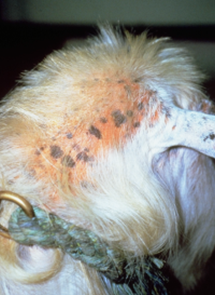
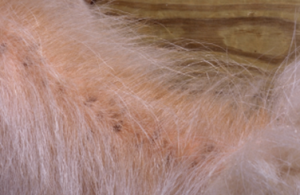
-
-
- Clinical signs are as described for cattle.
-
-
- Swine:
- Haematopinus suis has been implicated in the transmission of swine pox.
- It causes pruritic dermatitis.
- Haematopinus suis louse is found on all parts of the body but it seems to favor skin folds such as the neck, jowls and flank.
- The ear canals seem to be a favorite place for lice.
- Swine:
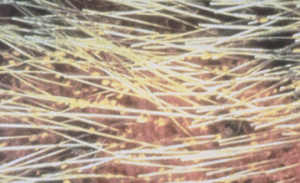
-
Diagnosis
- History and clinical signs.
- Lice and/or nits demonstration. They are usually easily visible.
- Examine the hair coat closely for presence of adults. Eggs (nits) are glued to hair shaft.
- Check the skin folds and the ear canals.
- A stiff bristle brush can be used to brush scale and lice into a pan to facilitate collection and identification. A flea comb can also be used for this purpose.
- A magnifying glass may help recognize them.
-
Treatment
- Treatment of pediculosis is usually easy and effective.
- Use approved water-based insecticide sprays or powders.
- 0.05 to 0.2% coumaphos, 0.1 to 1.0% crotoxyphos, 0.55% malathion and pyrethrins have been effective.
- The hair coat should be thoroughly moistened if using a parasiticide solution.
- Special attention should be given to the ears.
- Most insecticides are not ovicidal, therefore, treatment should be repeated in 2 weeks.
- Lice infested sheep are treated with organophosphates used as dips or sprays under high pressure.
- Dusting of sheep in inclement weather is preferable than spraying.
- Treatment of goats producing milk for human consumption should be restricted to approved insecticides such as 1% Ciodrin Insecticide Solution (Southern Agricultural Insecticides, Inc.; Palmetto, FL), which contains crotoxyphos in a ready-to-use spray formulation or 3% dust. Coumaphos 0.25% in water spray or 0.5% dust are other options.
- Flea collars, flea powders labeled for cats and rotenone may be used on pet goats.
- Clipping the animal before treatment will improve efficacy.
- Dusts are preferable to dips in cold weather.
- One dose of fipronil spray (0.5%) was shown to be effective in a herd of 22 horses with lice. Eggs or lice were not noted in any of the horses after 7 days of treatment.
- One dose of a 10 mg/mL deltamethrin-based pour-on solution was successfully used to treat and prevent lice infestation (Damalinia equi) in horses. Each horse in the study received 10 mL of the solution from the mane to the tail.
- Ivermectin has been reported to be effective to treat sucking lice in swine, cattle, and goats. A single subcutaneous injection at a dose of 0.2 to 0.3 mg/kg is recommended.
- A report showed that a single application of doramectin pour-on at the dosage of 0.5 mg/kg (1ml /10kg) was 100% effective against cattle Solenopotes capillatus (14 days after treatment); Haematopinus eurysternus and Linognathus vituli (21 days after treatment); and Damalinia bovis (28 days after treatment).
- Another study showed that a single pour-on application of five endectocides at the dosage of 1 ml/10kg was very efficacious against all types of cattle lice. The five endectocides used in the study include Eprinex® (eprinomectin), Ivomec® (ivermectin), Phoenectin® (generic version of Merial’s ivermectin), Dectomax® (doramectin) and Cydectin® (moxidectin).
- For information on the control of chewing lice using biologicals and plant-based insecticides, refer to the review by Benelli and collaborators.
Important Facts
- Louse infestation is a common problem in large animals.
- Lice are a greater problem during the winter months.
- Lice are highly host-specific and spend their whole life cycle on the host.
- Lice typically live off the host for less than 7 days but they can live more than 2 weeks under ideal environmental conditions.
- Unless infestations are heavy, lice are not harmful to the animal.
- Heavy infestation causes pruritus and restlessness.
- Most animal species can be infested with biting or sucking louse.
- Sucking lice are usually found around the poll, nose, eyes, neck, brisket, withers, tail, axillae, and groin. Heavy and chronic infestation can cause anemia.
- Biting lice prefer the neck, wither and tail head.
- Louse infestation may produce substantial economic losses through decreased weight gains, decreased milk production, hide and wool damage, anemia and increased susceptibility to other diseases.
- Treatment of lice is usually easy and effective.
References
Benelli G, Caselli A, Di Giuseppe G, et al. Control of biting lice, Mallophaga − a review. Acta Trop 2018; 177: 211-219.
Campbell JB, Boxler DJ, Davis RL. Comparative efficacy of several insecticides for control of cattle lice (Mallophaga: Trichodectidae and Anoplura: Haematopinidae). Vet Parasitol 2001; 96:155-164.
Castilla-Castano E, Vischi A, Navarro C et al. Control of lice infestation in horses using 10 mg/mL deltamethrin topical application. Irish Vet J 2017; 70: 22.
Da Silva AS, Tonin AA, Lopes LS. Outbreak of lice in horses: epidemiology, diagnosis, and treatment. J Equine Vet Sci 2013; 33: 530-532.
Fadok VA, Mullowney PC. Dermatologic diseases of horses part I. Parasitic dermatoses of the horse. Comp Cont Educ 1983; 5:S615.
Rooney KA, Illyes EF, Sunderland SJ et al. Efficacy of a pour-on formulation of doramectin against lice, mites, and grubs of cattle. Am J Vet Res 1999; 60(4): 402-404
Scott DW. Large Animal Dermatology. 1st edn. Philadelphia: W.B. Saunders, 1988; 235-238.

